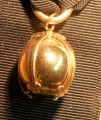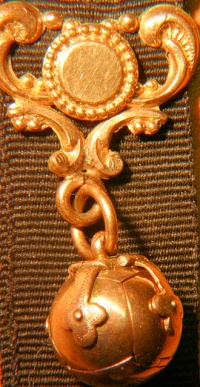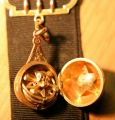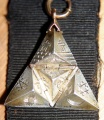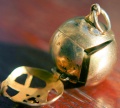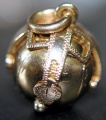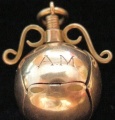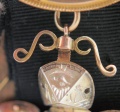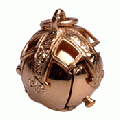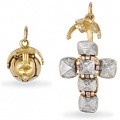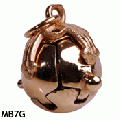En:FOB
English Masonic FOB Collection
This beautiful FOB collection belongs to Brother En:Mike Martin of Mersey Lodge No. 5434 (UGLE) If you would like to contact Brother Mike about his collection go to: Forum: "The freemason" where he is a Moderator.
Long Armed Victorian Ball
This is one of the rarer late 19th Century balls with the longer arms that all fix into the base. The arms are stamped 9ct and are fixed to a swivel that allows them to rotate on the ball when undone. The base has the stamp “PAT 2639 1/20 and REGd. Length 40mm by 30mm when open, weighs 10.2 grams.
Masonic Ball FOB
This is a magnificent 9ct gold Masonic ball fob in virtually mint condition, it is stamped 9ct on the clasp the central bit on the ribbon & on the star inside the ball along with a registration no 691741 by L&G ltd which indicates that it was made on commission or a limited number. I have only ever seen 2 of these, as most of them are a ball which opens out into a cross. It is 4-3/4" long unopened, it dates from late 19th to early 20th century.
Setting Maul FOB
A wonderful antique English, solid 9 carat rose gold cased Masonic fob / seal; terrifically crafted and opening to form a five pointed star, the interior formed by solid sterling silver pyramids with a soft gilt finish and hand engraved Masonic craft symbols. Each arm with its own separately hinged bracket. The base is engraved D.J.W. in reverse. Not marked but from around 1900-1920. 25.2 mm tall, base 14.6 mm diameter (1 inch = 25.4 mm) weighs approx.6.0 grams.
Five-Sided Pyramid FOB
A beautiful opening fob in the form of a 5-sided pyramid finished in yellow gold. It is hallmarked as 9ct at the clasp and has R.J REG 682301 stamped on the outside of one side. It opens out into a five pointed star. Approx 24mm tall when closed, when open it is approx 50mm across and Weight is 5.9grams.
Three-Sided Pyramid FOB
A beautiful opening fob in the form of a 3-sided pyramid finished in rose gold. It is hallmarked as 9ct at the clasp and has REGd stamped on the outside. It opens out into an equilateral triangle. Approx 17mm tall when closed sides of triangle are 27mm and Weight is 2.7grams.
Scottish Ball FOB
This is a very rare “Scottish” ball which according to authorities was actually made in Scotland. The main difference between it and the English balls is that the clasp is in the form of a gold Square & Compasses with the Letter G The clasp is hinged at the bottom of the ball with a clip at the top this opens and swivels down allowing the segments to open out into the form of a cross. It only has a couple of symbols in common with the common English ball.
"Edwardian" Ball
A vintage fob charm, nicely detailed all round, the 6 pyramids have hand engraved and well defined Masonic symbols. A superb quality Masonic ball, it has the maker’s initials J.H.W. on the clasp, 9ct & Sil on the charm, also stamped "MADE IN ENGLAND" which show this to be early 20th century (1900 – 1930). This fob measures 35mm (not including clasp) in length by 26mm wide when open and 14mm tall (not including link and jump when closed. It weighs around 7.6 grams
Victorian, Silver Gilt Standard
(with inverted cross)
From the outside this looks like a common or garden variety of the late 19th Century English version of the opening Ball or Orb fobs. However, as soon as it opens you notice a big difference, it opens out into a cross but the cross itself is inverted. I believe that this variant was intended so that wearer himself could study it whilst still wearing it (much like a Nurse’s fob watch). The engravings are of a very high quality with the usual Craft symbolism found. It is hallmarked 9Ct.S on outside of base segment. Length 45mm by 35 mm across when open, weighs 8.2 grams.
Victorian, Silver Gilt Screw Catch
This fob dates probably from the early 1900's but is a definite rarity. The maker excelled himself with a unique screw top latch and the fact that its symbolism includes the extra degrees of Royal Arch and Mark Mason.
The ball has a screw top latch which has a scroll work design surrounding a bale. The back most and foremost piece each have half of the screw, there are also lugs inside on the faces of two pyramids to hold it all together.
The symbols are most excellent with very fine detail. The top arm has the all-seeing eye below an arch with a Keystone, two columns and a set of stairs. The right arm bears a square and compass, a ruler, a compass above a window, and sprigs of acacia. The left arm has a square and compass, an hourglass, a folding ruler, and a gavel. The centre of the cross has a square, compass and G, a square, an altar, a bottle. The next bears the symbol for the 47th Prop of Euclid, a pestle, three stacked blocks, and a skull and crossbones. The bottom piece bears the Star of David, the Triple-Tau, a crossed pick axe, shovel and crowbar, and what looks to be a potted plant..
The bottom of the fob is stamped PAT. APP. FOR 9 CT. It also has the initials A.M. The ball weighs approx 10.0 grams. Approximately 12 mm in diameter, when opened 33 mm across, and 52 mm from the top of the cross to the bottom. (Bitte Übersetzen)
Joachim Ringelnatz as a hermetic Mariner
A hermetic golden ball
From his early encounter with Masonic symbols in connection with a golden ball Ringelnatz reported in 1932 in "The bottle on the way"
Next morning. I got up very early, because I believed to forget the Clock
at the theatrical wardrobe and had been worried.I loved that
Clock much, and even more of a golden ball with a
gold chain hanging out and an interesting Masonic symbol
was that I had bought in America in the year 1901 from a sailor.
This ball. I had it as a En:Talisman with me.
Ringelnatz had acquired during his first voyage as a cabin boy so-called golden Masonic ball. Six gold, cross-shaped ball arranged pyramidal sectors, decorated with engraved Masonic symbols total twenty-four have pie-interior surfaces, folded form such a ball. The selection and order of the symbols shown here are subject to any rule.
In addition, general rules go. No vessel will end impunity on Friday. Add to Chapter superstition is also the golden ring, which some people wear in the ear and is supposed to protect against eye diseases. "
Masonicgiftware
Videos
<videoflash>JKS9W1siDN8</videoflash>
Links
- http://mof.org.au/images/stories/pamphlets/Golden_Cross_and_Globe.pdf Variations on the FOB
- http://www.masonicjewellery.co.uk/acatalog/Masonic_Fobs_and_Masonic_Balls.html Masonic Jewellery




